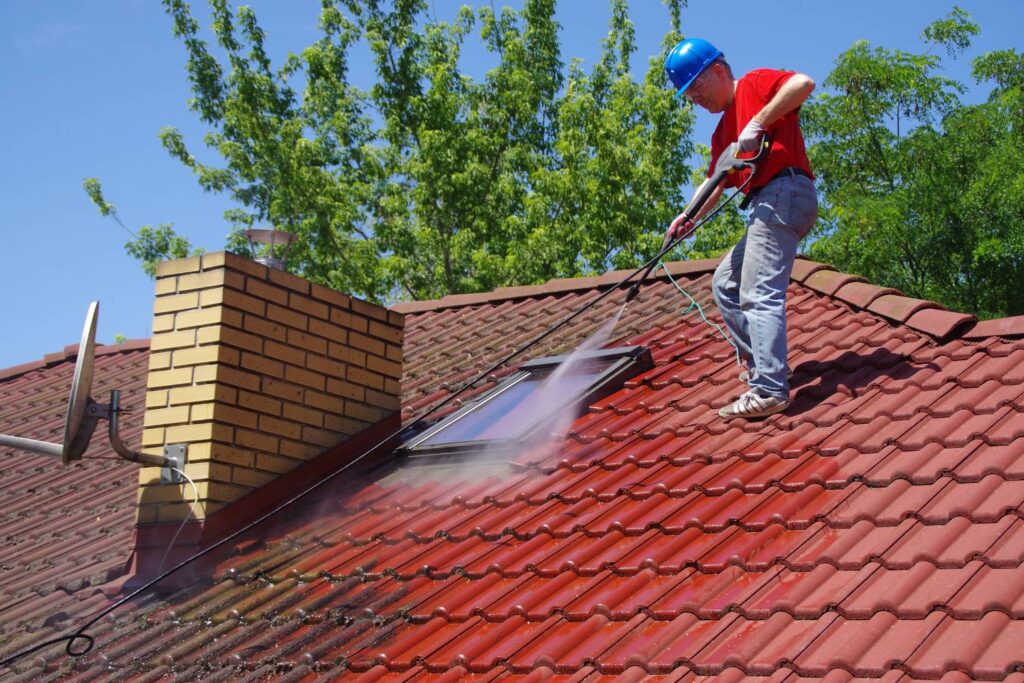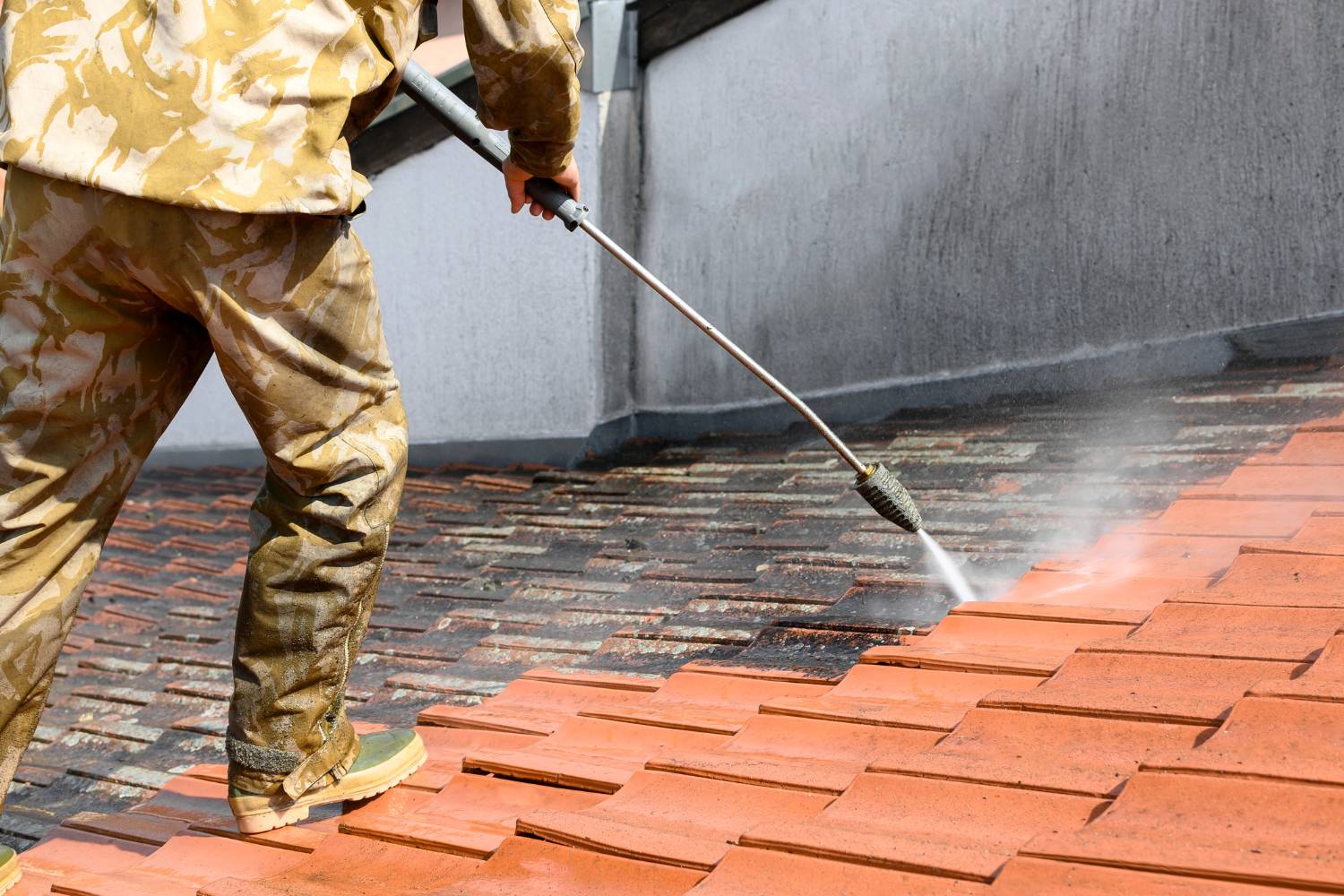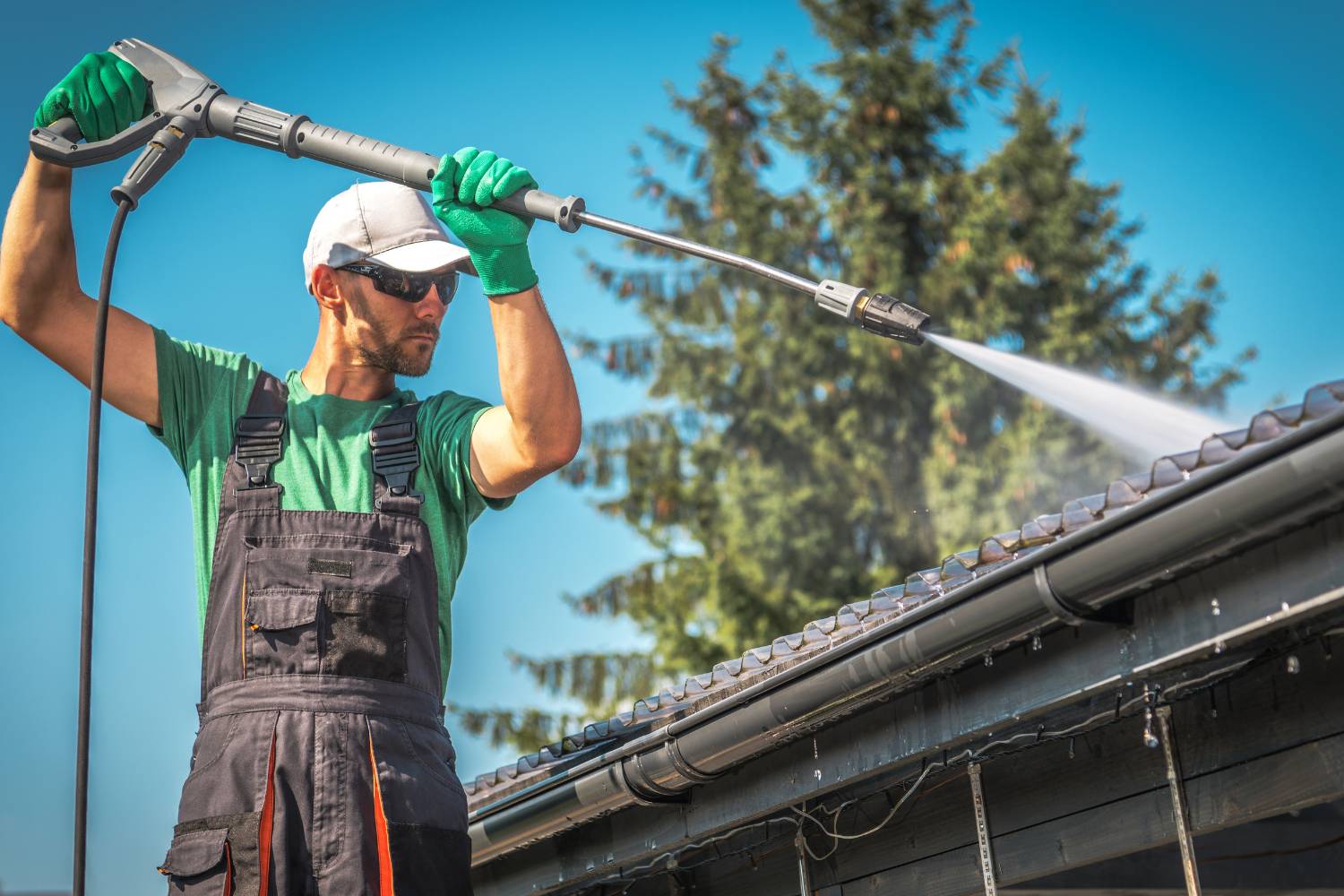Pressure washing is a powerful method for roof restoration, utilising high-pressure water to remove dirt, grime, mould, and mildew. It involves a motor, high-pressure pump, hose, and nozzle to direct the water effectively.
This technique not only cleans but also extends your roof's lifespan by preventing harmful buildup, improving energy efficiency, and enhancing curb appeal. Regular cleaning can prevent structural damage and ensure safety by removing slippery algae.
Deciding between DIY and professional pressure washing depends on project size, cost, and expertise. While DIY can be economical for small tasks, professionals offer thorough and safe cleaning for larger projects.
Regular maintenance, including pressure washing every one to two years, gutter cleaning, and protective coatings, keeps your roof in top condition, ensuring longevity and improved appearance.
What Is Pressure Washing And How Does It Work?
Pressure washing is a powerful cleaning method that uses high-pressure water spray to remove dirt, grime, mould, mildew, and other contaminants from surfaces. This method is effective for cleaning a variety of surfaces, including concrete, brick, wood, and siding. Here’s a detailed look at what pressure washing is and how it works.
How Does Pressure Washing Work?
Pressure washing equipment consists of a motor (either electric or gas-powered) that drives a high-pressure pump, which forces water through a narrow nozzle. The water’s force is what makes pressure washing such an effective cleaning method. Here’s a breakdown of the key components and their functions:
- Motor or Engine: Powers the high-pressure pump.
- High-Pressure Pump: Increases the water pressure from the garden hose level (around 40-60 PSI) to high-pressure levels (typically between 1,300 to 4,000 PSI).
- High-Pressure Hose: Carries the high-pressure water from the pump to the nozzle.
- Nozzle: Directs the water at the surface to be cleaned. Nozzles come in different angles and spray patterns for various cleaning tasks.
Professional Vs. Diy
While DIY pressure washing can be effective for smaller tasks, hiring a professional may be beneficial for larger or more complex projects. Professionals have the expertise and equipment to handle various surfaces safely and efficiently.
Pressure washing is a versatile and powerful cleaning method that, when used correctly, can significantly improve the appearance and longevity of your property’s surfaces. By understanding how it works and following the proper procedures, you can achieve excellent cleaning results.
Why Is Pressure Washing Important For Roof Restoration?
Pressure washing plays a critical role in maintaining and restoring the condition of your roof. By utilising high-pressure water jets, this method effectively removes dirt, debris, mould, algae, and other contaminants that can compromise your roof's integrity and appearance. Here’s why pressure washing is essential for roof restoration:
Extending Roof Lifespan
Regular pressure washing helps extend the lifespan of your roof by preventing the buildup of harmful substances. Dirt, algae, and moss can cause deterioration over time, leading to premature ageing and potential damage. By removing these elements, pressure washing ensures your roof remains durable and functional for many years, saving you from costly repairs or replacements.
Improving Energy Efficiency
A clean roof reflects sunlight more effectively, reducing heat absorption. When dirt and algae accumulate, they trap heat, making your home warmer and increasing the load on your cooling systems. Pressure washing eliminates these contaminants, enhancing your roof's reflectivity and improving your home’s overall energy efficiency. This can lead to lower energy bills and a more comfortable indoor environment.
Enhancing Curb Appeal
A well-maintained roof significantly boosts your home’s curb appeal. Over time, roofs can become stained and discoloured due to algae, mould, and debris. Pressure washing restores your roof's original appearance, making your home look cleaner and more attractive. This is especially important if you plan to sell your property, as a clean roof can make a strong first impression on potential buyers.
Preventing Structural Damage
Accumulated debris and biological growths like moss and algae can retain moisture, leading to water damage and compromising the roof’s structural integrity. Pressure washing removes these harmful elements, preventing water from seeping into the roofing materials and causing rot or other structural issues. This proactive maintenance step helps preserve the roof’s condition and prevents long-term damage.
Safety And Health Benefits
Mould and mildew not only damage your roof but also pose health risks to your household. These fungi can trigger allergies and respiratory issues. By pressure washing your roof, you eliminate these hazards, ensuring a healthier living environment. Additionally, removing slippery algae improves the safety of your roof, reducing the risk of accidents during maintenance.
How Often Should You Pressure Wash Your Roof?
Maintaining your roof's cleanliness is crucial for extending its lifespan and enhancing your home's curb appeal. Regular roof cleaning is essential for extending the lifespan of your roof and maintaining its appearance.
Soft washing is the preferred method for most roof types and should be done every one to two years. Pressure washing should generally be avoided unless dealing with specific materials like ceramic or concrete tiles. Hiring a professional ensures safe and effective cleaning, preventing potential damage to your roof.
Why Clean Your Roof?
Cleaning your roof is essential to prevent the buildup of algae, moss, and debris, which can cause significant damage over time. A clean roof not only improves your home's appearance but also allows for early identification of potential issues, such as loose shingles or flashing. Regular roof cleaning can significantly extend the life of your roof by preventing these types of damage.
What Are The Steps Involved In Pressure Washing A Roof?
Pressure washing a roof is a task that requires careful preparation and execution to avoid damage and ensure thorough cleaning. This guide will walk you through the essential steps to pressure wash your roof safely and effectively.
Preparation And Safety Precautions
Before starting, it's crucial to prioritise safety. Wear non-slip shoes, safety goggles, gloves, and a mask to protect yourself from debris and cleaning agents. A safety harness with a lanyard and lifeline is recommended, especially if you need to climb on the roof. Additionally, ensure that your work area is clear of any people or pets to prevent accidents.
Equipment And Cleaning Solutions
You will need a pressure washer with a pressure rating between 140 to 160 bar, which is powerful enough to clean effectively without causing damage. Equip your pressure washer with a 35-degree spray nozzle for a wide and gentle spray, and have an extension hose and telescopic lance ready to reach all areas of the roof. Use eco-friendly cleaning solutions specifically designed for roofs to avoid damaging the shingles and surrounding vegetation.
Initial Inspection And Setup
Begin by inspecting your roof for any loose shingles, tiles, or flashing that might need repair. Secure all connections on your pressure washer, check the oil and water levels, and ensure the pressure settings are correct to avoid stripping granules from the shingles. If the roof has moss or algae, apply a moss control product beforehand to loosen the growth.
Cleaning Process
- Start at the Top: Begin at the top of the roof and work your way down to prevent water from getting under the shingles. Wet the roof with plain water to prepare the surface.
- Apply Cleaning Solution: Using a foam cannon or the pressure washer’s detergent tank, apply the roof cleaning solution evenly. Let it sit for a few minutes to break down dirt and grime, but do not let it dry completely.
- Pressure Wash: With the pressure washer on a low setting, clean the roof using a side-to-side motion. Keep the nozzle moving to avoid concentrating pressure on one spot, which can damage the shingles.
- Rinse Thoroughly: Rinse off the cleaning solution with water, ensuring all detergent and debris are washed away. Work in small sections to prevent the detergent from drying on the shingles.
Moss And Algae Removal
For roofs with significant moss or algae growth, start by brushing off as much as possible with a soft-bristled brush. Apply a moss control solution, let it sit according to the product instructions, and then rinse thoroughly. Avoid using bleach as it can discolour the roof and harm surrounding plants.
Gutter Cleaning
Finish by cleaning the gutters to remove any debris that might cause blockages. Use a gutter cleaning attachment on your pressure washer to clear out leaves and other materials efficiently.
Final Inspection And Cleanup
Once the roof is clean, inspect it to ensure no areas were missed and that there is no damage. Clean and store your equipment properly, making sure all accessories are in good condition for future use.
Should You Hire A Professional Or Do It Yourself?
When it comes to pressure washing your property, the decision to hire a professional or do it yourself (DIY) can be challenging. Both options have their own set of benefits and considerations. This blog will explore the factors to help you make an informed decision.
Cost Considerations
Cost is a significant factor when deciding between hiring a professional and doing it yourself. Professional pressure washing services generally come with higher upfront costs because you are paying for the labour, expertise, and equipment.
On the other hand, DIY pressure washing can be more cost-effective as you only need to rent the equipment and buy any necessary cleaning solutions. However, there are hidden costs to consider with DIY, such as the potential for damage if the job is not done correctly, which could lead to more expensive repairs.
Equipment And Expertise
Professional pressure washers bring industry-standard equipment to the job, ensuring effective and safe cleaning. These professionals are also knowledgeable about the best cleaning agents and techniques for different surfaces, minimising the risk of damage. In contrast, DIY pressure washing involves renting equipment, which might not be as powerful or well-maintained as professional tools. Additionally, using a pressure washer correctly requires some practice and understanding, which professionals already possess.
Project Size And Complexity
The size and complexity of the project play crucial roles in your decision. For larger projects, such as cleaning extensive commercial properties or heavily soiled areas, hiring a professional might be more efficient and practical. Professionals can handle large-scale jobs quickly and effectively. For smaller, more manageable projects, DIY pressure washing can be a feasible option, especially if you have some experience with the equipment.
Time And Effort
Time is another critical factor. Hiring a professional saves you the time and effort involved in pressure washing. Professionals handle everything from setup to cleanup, allowing you to focus on other tasks. In contrast, DIY pressure washing requires significant time investment, not only in performing the task but also in learning how to use the equipment properly and safely. If you have a busy schedule, hiring a professional might be the better option to avoid the hassle.
Safety And Risks
Safety is a paramount concern with pressure washing. High-pressure water can cause injuries if not handled correctly and can also damage surfaces if used improperly. Professionals are trained to operate pressure washers safely and effectively, reducing the risk of injury and property damage. DIY pressure washing, while potentially less expensive, comes with higher safety risks, especially for those unfamiliar with the equipment.
Effectiveness And Results
The effectiveness of the pressure washing job is another crucial consideration. Professional pressure washers use commercial-grade equipment that can achieve better results than rental machines. They also have access to advanced cleaning agents and know how to tackle stubborn stains and grime effectively. DIY pressure washing might not achieve the same level of cleanliness, especially for tough jobs.
What Should You Do After Pressure Washing Your Roof?
Pressure washing your roof can significantly improve its appearance and longevity by removing dirt, grime, mould, and other contaminants. However, what you do after pressure washing is equally important to ensure your roof remains in good condition. This guide will walk you through the essential steps to take after pressure washing your roof.
Allow Proper Drying Time
One of the most crucial steps after pressure washing your roof is to allow sufficient drying time. The drying period can vary depending on several factors, including climate, roofing material, and the extent of washing. Generally, you should wait between 24 hours to 3 days before moving on to the next steps. In hot and dry climates, the roof may dry within a day, while in cooler or more humid conditions, it could take longer.
Proper drying time ensures that all water and cleaning solutions have evaporated, preventing potential damage such as mould growth or material degradation. It also provides a safe environment for any additional work you might need to perform on the roof.
Inspect For Damage And Needed Repairs
After your roof has dried, conduct a thorough inspection. Look for any signs of damage that may have occurred during the pressure washing process or pre-existing issues that need attention. Pay special attention to the following:
- Shingles or Tiles: Check for any loose, cracked, or missing shingles or tiles.
- Flashings: Ensure that the flashings around chimneys, vents, and other roof penetrations are intact and secure.
- Gutters: Inspect your gutters for debris buildup and ensure they are firmly attached and functioning correctly.
- Address any issues promptly to prevent further damage. Replace damaged shingles or tiles and repair any other parts of the roof as necessary.
Apply A Protective Coating
Applying a protective coating after pressure washing can help preserve your roof’s condition. This coating can protect against UV damage, moisture infiltration, and algae or mould growth. Depending on the type of roof you have, you might choose from various products, such as waterproof sealants or algae-resistant treatments.
Ensure that the roof is completely dry before applying any protective coatings. Follow the manufacturer's instructions for the best results.
Clean And Maintain Gutters
Pressure washing can dislodge a significant amount of debris, which often ends up in your gutters. After pressure washing, clean out the gutters thoroughly to ensure they are free from obstructions that could lead to water damage or poor drainage.
Regularly maintaining your gutters by removing leaves, twigs, and other debris helps prevent overflow and extends the life of both your gutters and roof.
Schedule Regular Maintenance
Regular maintenance is key to prolonging the life of your roof. Create a maintenance schedule that includes:
- Annual Inspections: Have a professional inspect your roof annually to catch any potential issues early.
- Routine Cleaning: Consider pressure washing your roof annually or bi-annually, depending on the environmental conditions and buildup.
- Minor Repairs: Address minor repairs promptly to avoid more significant problems down the line.
Implement Bird And Pest Control Measures
Bird droppings and nests can cause significant damage to your roof. Implementing bird control measures, such as installing spikes or bird nets, can help keep your roof clean and in good condition. Additionally, check for any signs of pests, such as insects or rodents, and take appropriate measures to eliminate them.
Conclusion
Pressure washing is a crucial aspect of roof restoration, utilising high-pressure water to effectively clean and maintain your roof. This method extends your roof's lifespan by removing harmful substances, improving energy efficiency, and enhancing curb appeal.
Regular pressure washing, along with other maintenance practices like gutter cleaning and applying protective coatings, ensures your roof remains in excellent condition. Whether you choose to do it yourself or hire a professional, understanding the benefits and proper techniques of pressure washing will help you make the best decision for your roof’s care and longevity.
Frequently Asked Questions
Regular roof cleaning is essential for maintaining its appearance and longevity. Generally, pressure washing should be done every one to two years, depending on environmental conditions and the type of roof material. Soft washing is preferred for most roofs, while pressure washing is reserved for materials like ceramic or concrete tiles.
If not done correctly, pressure washing can potentially damage your roof. High-pressure water can strip away protective granules from shingles and force water under the roofing material, causing leaks. It is crucial to use the appropriate pressure settings and techniques or hire a professional to avoid damage.
Pressure washing removes dirt, algae, moss, and other contaminants that can cause deterioration, extending the lifespan of your roof. It also improves energy efficiency by enhancing reflectivity, boosts curb appeal by restoring the roof's appearance, and prevents structural damage by removing moisture-retaining debris.
Deciding between DIY and professional pressure washing depends on the project size, cost, and your expertise. While DIY can be cost-effective for small tasks, professionals offer thorough and safe cleaning for larger or more complex projects. They have the necessary equipment and expertise to ensure optimal results without causing damage.
When pressure washing your roof, prioritise safety by wearing non-slip shoes, safety goggles, gloves, and a mask to protect yourself from debris and cleaning agents. Use a safety harness with a lanyard and lifeline if you need to climb on the roof, and ensure your work area is clear of people and pets to prevent accidents.


